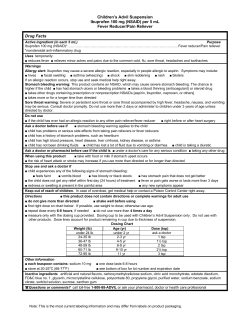
Protect yourself Is Valley Fever contagious?
Is Valley Fever contagious? Protect yourself No, Valley Fever is not spread from person to person, and Use caution when conducting activities associated with you cannot catch it from your pets. dust and airborne dirt. There is no vaccine available at How is Valley Fever treated? this time, although research is being conducted. If you have a condition that weakens your immune system, Most patients with Valley Fever recover with no consider avoiding high-risk activities associated with treatment, and will have life-long immunity. For persistent disturbing dirt, especially on windy days. symptoms, an antifungal drug is often prescribed. In severe cases, years of anti-fungal treatment may be required, and surgery may be necessary to remove damaged tissue. How is Valley Fever diagnosed? Blood testing for the cocci antibody and sputum testing for presence of cocci organisms are considered reliable only after three weeks or more from the onset of symptoms. Chest x-rays may show lung abnormalities associated with Cocci. Your doctor can order a test of blood or other bodily fluids. The specimen should be sent to either: Coccidioidomycosis Serology Laboratory School of Medicine UC Davis Davis, California 95616 Kern County Public Health Laboratory 1800 Mount Vernon Ave Bakersfield, CA 93306 San Luis Obispo County Public Health Department For more information on Valley Fever, contact: San Luis Obispo County Public Health Department (805) 781-5500 http://www.slocounty.ca.gov/health/publichealth/ commdisease.htm Valley Fever Center of Excellence Tucson, Arizona 85724 (520) 626-6517 http://www.vfce.arizona.edu What is Valley Fever? Centers for Disease Control and Prevention (CDC) http://www.cdc.gov/nczved/divisions/dfbmd/diseases/ coccidioidomycosis/ California Department of Public Health http://www.cdph.ca.gov/healthinfo/discond/Pages/ Coccidioidomycosis.aspx American Lung Association http://www.lungusa.org/lung-disease/coccidiodomycosis/ National Institutes of Health (NIH) http://www.ncbi.nlm.nih.gov/pubmedhealth/ PMH0002299/ Valley Fever (Coccidioidomycosis or “cocci”) is a disease caused by the spores of a fungus (Coccidioides) that can infect lungs, and in some cases spread to other parts of the body… …more about Valley Fever Who gets Valley Fever? Valley Fever (Coccidioidomycosis or “cocci”), is a disease The disease may occur in anyone who lives, works, or What are the symptoms of Valley Fever? caused by the spores of a fungus (Coccidioides) that lives visits an area where Valley Fever occurs. People most The disease may not produce any symptoms at all, or in soil in the southwest region of the United States, likely to be exposed are those who are in dusty flu-like symptoms may occur within one to three weeks Mexico, Central and South America. When soils where occupations such as farm workers, construction after exposure. the fungus lives are disturbed by wind, construction, workers, and archaeologists. Recreational activities in farming, grading, digging or earthquakes, fungal spores affected areas, such as off-road biking, 4-wheeling and Exposure symptoms can include: can become airborne. Cocci is present in San Luis Obispo driving ATVs can increase the risk of exposure. County, and infection can occur year-round. Once Domestic and wild animals are also susceptible to inhaled, the spores make their way into the tiny air sacs infection. Over 60% of infected people either have no deep in the lungs. There the spores can then infect lungs, symptoms, or experience flu-like symptoms. Of the 30 and in some cases spread to other parts of the body. In to 40% who develop symptoms, most will experience less than 1% of cases, the disease can be fatal. a sudden onset of mild to severe flu-like symptoms, and will recover without treatment. A small percentage—between 1 and 5 percent—of those who experience symptoms will develop the much more SLO County Known highly endemic area Endemic area (established) Suspected endemic area Source: http://valleyfever.com/wp-content/uploads/2010/05/usamap.jpg How common is Valley Fever in San Luis Obispo County? For most people, symptoms disappear on their own within a month or so, although full return of energy may take up to six months. serious disseminated form of the disease. This form Some persons develop disseminated disease, which can occurs more often in persons with immune system be potentially fatal. The disseminated form of the disease deficiencies, such as those infected with HIV/AIDS, occurs when the fungal infection spreads to other parts of women who are pregnant, persons on chronic corticoste- the body. roid therapy, persons on chemotherapy, and darkskinned patients – those of Hispanic, African American, Native American, and Filipino descent. Public Health Department confirmed 686 cases of What should I do if I think I have been exposed and become sick? Valley Fever. A map depicting this information is If you suspect that you may have been exposed to Valley available on the County Health Department’s website. Fever and are experiencing flu-like symptoms that have The Public Health Department tracks these cases not improved over several weeks, you should go to your through reporting by medical providers, and in turn, local health care provider, Urgent Care clinic, or hospital keeps local medical providers apprised of any new or for evaluation and testing for Valley Fever. Be sure to relevant information on the incidence, detection and inform your health care provider that you may have been treatment of this disease. exposed to Valley Fever. Between the years 2000 and 2007, San Luis Obispo • fever • coughing • chest pain • shortness of breath • body aches and joint pain • skin rash • night sweats • fatigue Disseminated symptoms can include: • very high fever • extreme fatigue • nodules or ulcers on the skin • painful lesions on the skull, spine, or other bones • painful, swollen joints • headaches and or back pain from infection of the brain or spinal cord
© Copyright 2025





















